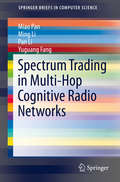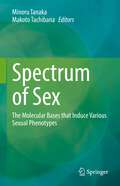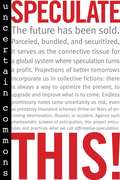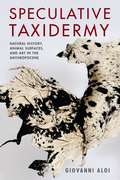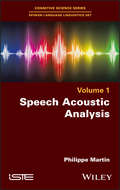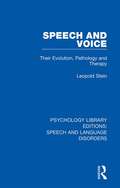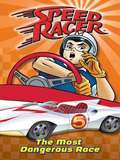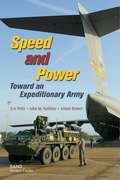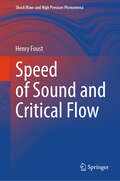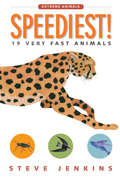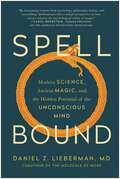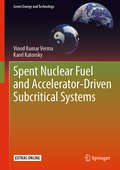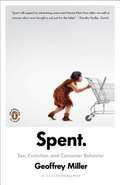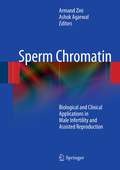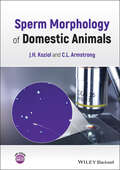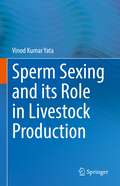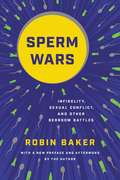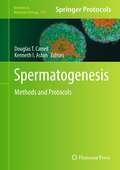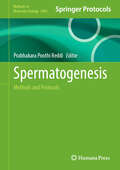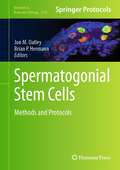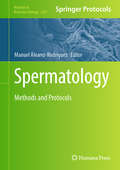- Table View
- List View
Spectrum Trading in Multi-Hop Cognitive Radio Networks
by Ming Li Miao Pan Pan Li Yuguang FangThis SpringerBrief focuses on spectrum trading designs in multi-hop cognitive radio networks. It starts with the motivation for spectrum trading and the review of existing spectrum trading designs. Then, it presents a novel CRN architecture for spectrum trading considering spectrum trading's economic features and wireless nature. Under this network architecture, it extends current single-hop per-user based spectrum trading design into a multi-hop transmission opportunity based one, and further into a session based one, while having economic properties guaranteed. This SpringerBrief not only provides a good review of current spectrum trading designs, it also touches on the cutting-edge interdisciplinary spectrum trading research on disparate fields of modeling, network architecture design, optimization theories, statistics, and economic theories. Advanced-level students studying computer science, electrical and computer engineering and economics, wireless network planners, and wireless spectrum engineers will find this book a useful tool.
Spectrum of Sex: The Molecular Bases that Induce Various Sexual Phenotypes
by Minoru Tanaka Makoto TachibanaThis book introduces cutting-edge studies on the spectrum of sex. The sex spectrum can be understood as an interwoven mechanism sustaining graded phenotypes between the two sexes. The book overviews three elements that develop the sex spectrum: genetics, the endocrine system, and the environment. Part I discusses the genetic regulation during sex determination, which often results in a mixture of two sexes or sex reversal. The evolutionary aspects of the genetic determinants are also discussed. Part II presents the involvement of endocrine regulation in the sex spectrum, which covers a broad range of phenotypic events, including sexual behavior and metabolism. Interestingly, sex hormones can also act as sex determinants. Finally, Part III shows that intrinsic factors, such as sex-determining genes and sex hormones, are not the only factors in sex development. The environment surrounding organisms, such as symbiosis and metabolism, act on the sex as critical factors, generating the sex spectrum. Determination and development of the two sexes have been a topic of great interest and a long-standing issue in biology. The book updates the conventional view that biological sex is fixed after birth and sets new perspectives for understanding sex as a spectrum manifested in multiple phenomena. Each chapter contributed by leading experts explains the sex spectrum in various organisms and their underlying mechanisms from the latest ongoing studies. The book provides a valuable resource for not only experts in developmental biology, physiology, and medical science, but also non-scientists and anyone interested in the topic.
Speculate This!
by Uncertain CommonsA short, timely manifesto critiquing predatory modes of financial speculation that seek to minimize uncertainty and risk, while advocating speculative practices that embrace uncertainty, spur radical change, and enable alternative futures.
Speculative Taxidermy: Natural History, Animal Surfaces, and Art in the Anthropocene (Critical Life Studies)
by Giovanni AloiTaxidermy, once the province of natural history and dedicated to the pursuit of lifelike realism, has recently resurfaced in the world of contemporary art, culture, and interior design. In Speculative Taxidermy, Giovanni Aloi offers a comprehensive mapping of the discourses and practices that have enabled the emergence of taxidermy in contemporary art. Drawing on the speculative turn in philosophy and recovering past alternative histories of art and materiality from a biopolitical perspective, Aloi theorizes speculative taxidermy: a powerful interface that unlocks new ethical and political opportunities in human-animal relationships and speaks to how animal representation conveys the urgency of addressing climate change, capitalist exploitation, and mass extinction.A resolutely nonanthropocentric take on the materiality of one of the most controversial mediums in art, this approach relentlessly questions past and present ideas of human separation from the animal kingdom. It situates taxidermy as a powerful interface between humans and animals, rooted in a shared ontological and physical vulnerability. Carefully considering a select number of key examples including the work of Nandipha Mntambo, Maria Papadimitriou, Mark Dion, Berlinde De Bruyckere, Roni Horn, Oleg Kulik, Steve Bishop, Snæbjörnsdóttir/Wilson, and Cole Swanson, Speculative Taxidermy contextualizes the resilient presence of animal skin in the gallery space as a productive opportunity to rethink ethical and political stances in human-animal relationships.
Speech Acoustic Analysis
by Philippe MartinThe text sets out in simple and accessible terms the various methods of acoustic analysis of speech, placing them in their historical context, allowing a better understanding of the mathematical and technical solutions adopted today in phonetics and experimental phonology. Without mathematical complications, the operating bases of the many speech analysis software currently available are exposed so that everyone can understand the limits and avoid errors and misinterpretations in their implementation.
Speech and Language Impairments in Children: Causes, Characteristics, Intervention and Outcome
by Laurence B. Leonard Dorothy V.M. BishopDelayed development of speech and/or language is one of the commonest reasons for parents of preschool children to seek the advice of a paediatrician.Accessible to non-academic Speech and Language Impairments provides an overview of recent research developments in specific speech and language impairments, written by experts in the field. Topics include normal and disordered development of problems , crosslinguistic studies, pragmatic language impairments, early identification, educational and psychiatric outcomes, acquired epileptic aphasia and experimental studies of remediation. The book concludes with a chapter by Michael Rutter that gives guidelines for conducting and evaluating research in this field.
Speech and Voice: Their Evolution, Pathology and Therapy (Psychology Library Editions: Speech and Language Disorders)
by Leopold SteinOriginally published in 1942, this title was recognised as setting new standards in the scientific approach to speech problems. Much speech therapy in the past had been unsatisfactory because of its emphasis upon the purely mechanical aspects of the condition, while at the same time the purely psychological approach was not sufficient to lead to satisfactory and radical treatment either. In this title the author combines the two approaches and by setting out the basic pathology of the various conditions, he throws new light upon them. Today it can be read and enjoyed in its historical context.
Speed Bumps
by Smithsonian InstitutionSpeed Bumps is part of the Smithsonian Science Stories™ Literacy Series and has on-grade and below-grade leveled readers available to accommodate a range of readers in an elementary classroom. The line and dot graphic at the bottom of the front cover indicates the reading level. When the dot is at the top of the line, the reading level for the book is on-grade. When it is at the bottom, the book is below-grade. You can also find the official Lexile Scores for each reading in the Table of Contents. The books in this literacy series enhance and reinforce the science concepts taught in the Smithsonian Science for the Classroom™ curriculum units.
Speed Racer (The Most Dangerous Race #5)
by Chase WheelerDuring the Big Alpine Race, Speed Racer goes head-to-head against the amazing Car Acrobatic Team and the evil Capt. Terror. Both opponents plan on winning at all costs...
Speed and Power
by John Halliday Eric Peltz Aimee BowerUsing a case study based on the Army's new Stryker Brigade Combat Team, the authors explore how the Army might improve its ability to contribute to prompt, global power projection, that is, strategically responsive early-entry forces for time-critical events. The authors examine options to reach a dual goal: to initiate deployment of the right force capabilities, and then get those capabilities where they need to be as quickly as possible.
Speed of Sound and Critical Flow (Shock Wave and High Pressure Phenomena)
by Henry FoustThis book focuses on two related topics in fluid mechanics, that is, speed of sound through various media and critical flow associated with gas–liquid flows. The first part of the book explores the speed of sound in liquids, gases, and solids. For gas flows, both real gas behavior and two-phase flow are reviewed; a thorough review is given of cubic equations of state. For media of solid, transverse and longitudinal waves are discussed and related back to earlier work on acoustics and gas dynamics. The second part of the book focuses on critical flow. Beginning with ideal, perfect gases, it goes into van der Waals and other equations of state. A general discussion of gas–liquid flows is subsequently given with necessary nomenclature consistent with the work of Wallis, and lastly goes on to explore critical flow for two-phase and binary mixtures through Henry and Fauske's work and the Omega method by Leung.
Speediest!: 19 Very Fast Animals (Extreme Animals)
by Steve JenkinsCaldecott Honor winner Steve Jenkins is back with more Extreme Animals, perfect for young readers looking for accessible nonfiction chock full of incredible art. Speediest! will focus on the fastest members of the animal kingdom. Through illustrations, infographics, facts, and figures, readers will see how big each animal is compared to humans, where it lives on the globe, and just how quickly it can move! With his signature art style, Steve Jenkins' Extreme Animals reader series explores nature's truly superlative animals. These readers are fact-packed and span the globe, detailing the astounding abilities of every shape, size, and species. Each installment focuses on amazing and unusual animals, making these nonfiction readers accessible, informative, and fascinating.
Spellbound: Modern Science, Ancient Magic, and the Hidden Potential of the Unconscious Mind
by Daniel Z. LiebermanPsychiatrist Daniel Z. Lieberman, MD, reveals how to join forces with your unconscious to make better decisions, find more meaning in everyday life, and develop a richer, more balanced way of living. The conscious mind, the part of your mental life you experience directly, is responsible for only a tiny sliver of what science says is going on inside your brain. Most of what you experience, your moods, and the things you like or dislike—most of who you are—comes from a much more mysterious part of your mind: the unconscious. And to really understand the influences of the unconscious, says psychiatrist Daniel Z. Lieberman, coauthor of The Molecule of More, we need to look to something often considered science&’s alter ego: magic. Drawing on the work of Swiss psychiatrist Carl Jung, and with deep dives into what we can learn from ancient mystical traditions from alchemy to numerology to meditation, Spellbound weaves together ancient magical traditions, psychological research, and the latest neuroscientific discoveries, in order to bridge the gap between the conscious and unconscious mind. Like it or not, your unconscious is currently the source of most of your choices. It&’s the source of your passions, your energy, and your &“gut instinct.&” It can help you solve seemingly impossible problems with the gift of inspiration. But it&’s not always working in your favor: The unconscious is wild and untamed, often leading us down self-destructive paths that leave us baffled by our own decisions. Spellbound helps you take a new path: one where you learn how to recognize the influences of the unconscious, and make it an ally in helping you become the person you were meant to be. The human mind is perhaps the most mysterious thing in the universe. Science is only beginning to uncover its secrets, and some believe that we may never fully plumb its depths. But the ancient traditions of magic, traditions of understanding that have been built up over centuries, give us another window into the hidden facets of our humanity. After all, as the visionary Arthur C. Clarke once said, &“Any sufficiently advanced technology is indistinguishable from magic.&”
Spent Nuclear Fuel and Accelerator-Driven Subcritical Systems (Green Energy and Technology)
by Vinod Kumar Verma Karel KatovskyThis book offers a comprehensive overview of the reprocessing of spent nuclear fuels, and discusses the applications of radiation, particularly spallation neutrons and gamma rays. The unspent nuclear fuel of a reactor amounts to roughly 95 per cent of the loaded fuel. It contains both fertile and fissile fuels, minor and higher actinides and radioactive fission products. In 2015, out of approximately 4 million metric tons of spent fuel, only 90,000 metric tons was reprocessed worldwide; the rest was either sent to repositories, kept for cooling down, or put on a waiting list for future reprocessing. With regard to the direct reutilization of spent nuclear fuel, the new technique of ‘Energy Amplifiers’ has attracted considerable attention among the nuclear energy community. Presenting extensive information on this technique, the book is divided into eight major sections: (i) spent nuclear fuel and alternative transmutation methods, (ii) general concept of accelerator-driven subcritical systems (ADSS), (iii) spallation neutron sources and the possibility of incineration, (iv) requirements for nuclear data, (v) transmutation of spent nuclear fuel and extension of the fuel cycle, (vi) spallation neutron production facilities, (vii) major experimental facilities for ADSS, and (viii) software tools for the design and modelling of ADSS. The book is ideally suited as a textbook for graduate students as well as a reference guide for researchers and practitioners.
Spent: Sex, Evolution, and Consumer Behavior
by Geoffrey MillerA leading evolutionary psychologist probes the unconscious instincts behind American consumer culture Illuminating the hidden reasons for why we buy what we do, Spent applies evolutionary psychology to the sensual wonderland of marketing and perceived status that is American consumer culture. Geoffrey Miller starts with the theory that we purchase things to advertise ourselves to others, and then examines other factors that dictate what we spend money on. With humor and insight, Miller analyzes an array of product choices and deciphers what our decisions say about ourselves, giving us access to a new way of understanding-and improving-our behaviors to become happier consumers. .
Sperm Chromatin
by Ashok Agarwal Armand ZiniSperm DNA damage is common and has been associated with reduced rates of conception, impaired embryonic development and increased risk of miscarriage. Although the exact causes of sperm DNA damage are unknown, it is clear that infertile men possess substantially higher levels of sperm DNA damage than do fertile men. Written by leading, internationally renowned clinicians and basic scientists with expertise in sperm DNA, Sperm Chromatin: Biological and Clinical Applications in Male Infertility and Assisted Reproduction provides readers with a thoughtful and comprehensive review of the biological and clinical significance of sperm DNA damage. The work covers the fundamental principles of sperm chromatin architecture and function, the proposed modes of DNA damage and repair, the tests of sperm DNA damage, the clinical aspects of DNA damage and the impact of DNA damage on reproductive outcome. Unlike any other title on the topic, Sperm Chromatin: Biological and Clinical Applications in Male Infertility and Assisted Reproduction is an invaluable addition to the literature and will serve as an indispensable resource for basic scientists with an interest in sperm biology and for urologists, gynecologists, reproductive endocrinologists, and embryologists working in the field of infertility.
Sperm Morphology of Domestic Animals
by Jennifer Koziol Chance ArmstrongSperm Morphology of Domestic Animals A practical guide to interpreting sperm morphology of domestic animals Sperm Morphology of Domestic Animals is a concise, clinically-oriented resource for discovering any impairment to fertility caused by sperm anomalies in domesticated animals. As a bench-side reference, the book examines common sperm defects, their causes, and their prognosis for fertility. An easy-to-use reference, it is organized according to the placement of the deformity in the sperm to increase the speed of consultation, and to help with diagnosing fertility issues. Focusing particularly on the bull, stud horse, boar, ram, buck, and dog, it contains hundreds of high-quality color images accompanied by brief descriptions for additional diagnostic help. Readers will find: An easy-to-use reference work that is suitable for use next to the microscope Organization according to location of abnormality Hundreds if high-quality color images for easy comparison Brief descriptions accompanying each photo, for additional diagnostic help An ideal resource for veterinarians, andrologists, and veterinary students, Sperm Morphology of Domestic Animals fills a gap in current reproductive medicine resources with detailed information that is easy to consult.
Sperm Sexing and its Role in Livestock Production
by Vinod Kumar YataThis book presents basic principles and discusses the state-of-the-art methods of sperm sexing in livestock. It reviews the challenges and critical opinions on the conventional sperm sexing methods and characteristic features of spermatozoa of farm animals which could help to develop novel methods of sperm sexing. The book also presents principles and applications of flow cytometry for sperm separation. The chapters of the book elucidate methods and difficulties in developing sperm sexing methods. Notably, it covers recent research on immunological and nanotechnology-based sperm sexing methods. The book also provides information on the development of semen extenders. Towards the end, the book examines ethical and commercial aspects of sperm sexing. It is an ideal reference book for students, researchers and professionals working towards improving livestock production.
Sperm Wars: Infidelity, Sexual Conflict, and Other Bedroom Battles
by Robin BakerThis classic work on the rules of sex -- updated for a new generation -- is still as provocative as the day it was published, providing simple explanations for any and all questions about what happens in the bedroom.Sex isn't as complicated as we make it. In Sperm Wars, evolutionary biologist Robin Baker argues that every question about human sexuality can be explained by one simple thing: sperm warfare. In the interest of promoting competition between sperm to fertilize the same egg, evolution has built men to conquer and monopolize women while women are built to seek the best genetic input on offer from potential sexual partners.Baker reveals, through a series of provocative fictional scene, the far-reaching implications of sperm competition. 10% of children are not fathered by their "fathers;" over 99% of a man's sperm exists simply to fight off all other men's sperm; and a woman is far more likely to conceive through a casual fling than through sex with her regular partner.From infidelity, to homosexuality, to the female orgasm, Sperm Wars turns on every light in the bedroom. Now with new material reflecting the latest research on sperm warfare, this milestone of popular science will still surprise, entertain, and even shock.
Sperm Wars: Infidelity, Sexual Conflict, and Other Bedroom Battles
by Robin BakerPublished to acclaim and controversy a decade ago, Sperm Wars is a revolutionary thesis about sex that turned centuries-old biological assumptions on their head. Evolution has programmed men to conquer and monopolize women while women, without ever knowing they are doing it, seek the best genetic input on offer from potential sexual partners. In this book, best-selling author Robin Baker reveals these new facts of life: ten percent of children are not fathered by their "fathers;" less than one percent of a man's sperm is capable of fertilizing anything (the rest is there to fight off all other men's sperm); "smart" vaginal mucus encourages some sperm but blocks others; and a woman is far more likely to conceive through a casual fling than through sex with her regular partner. It's no wonder that Sperm Wars is a classic of popular science writing that will surprise, entertain, and even shock.
Spermatogenesis
by Lori Barnard Kenneth I. AstonDeficiencies in sperm function are usually the result of spermatogenic defects. Spermatogenesis is a biologically complex and essential process during which spermatogonia undergo meiotic recombination, reduction of the genome to a haploid state, and extensive cellular modifications that result in a motile cell capable of traversing the female reproductive tract, withstanding various potential assaults to viability, and finally successfully fertilizing a mature oocyte to give rise to an embryo. Defects in any step of spermatogenesis or spermatogenesis can lead to male infertility, a disease that affects approximately 5-7% of the population. Spermiogenesis and Spermatogenesis: Methods and Protocols details protocols used in the study of spermatogenesis, clinical analytical protocols, and basic techniques used in clinical andrology laboratories, such as obtaining accurate results for a sperm count, and advanced procedures, such as genome-wide genetic study tools and evaluation of nuclear proteins. Written in the successful Methods in Molecular BiologyTM series format, chapters include introductions to their respective topics, lists of the necessary materials and reagents, step-by-step, readily reproducible protocols, and notes on troubleshooting and avoiding known pitfalls. Authoritative and easily accessible, Spermiogenesis and Spermatogenesis: Methods and Protocols is unique in its breadth, and will be a useful reference for clinicians and researchers alike.
Spermatogenesis: Methods and Protocols (Methods in Molecular Biology #2954)
by Prabhakara P. ReddiThis volume presents a comprehensive collection of research methods at the cellular, molecular, and biochemical level to understand sperm production and function. Exploring spermatogenesis and testis biology, the book delves into epigenomics and transcriptomics, spermatogenic cell separation, identification of cell types and stages, and more. Written for the highly successful Methods in Molecular Biology series, chapters include introductions to their respective topics, lists of the necessary materials and reagents, step-by-step and readily reproducible laboratory protocols, and tips on troubleshooting and avoiding known pitfalls. Authoritative and practical, Spermatogenesis: Methods and Protocols serves as an excellent reference for basic applied researchers in the field of spermatogenesis and male fertility working with laboratory models as well as domestic animals.
Spermatogonial Stem Cells: Methods and Protocols (Methods in Molecular Biology #2656)
by Brian P. Hermann Jon M. OatleyThis volume explores the latest techniques used in the field of mammalian germ cell biology to study key experimental approaches and perspectives for critical analysis of spermatogonial subsets including the rare spermatogonial stem cells (SSCs) pool. Written in the highly successful Methods in Molecular Biology series format, chapters include introductions to their respective topics, lists of the necessary materials and reagents, step-by-step, readily reproducible laboratory protocols, and tips on troubleshooting and avoiding common pitfalls.Cutting-edge and comprehensive, Spermatogonial Stem Cells: Methods and Protocols is a valuable resource for both new and experiences investigators looking to expand their knowledge in this developing field.
Spermatology: Methods and Protocols (Methods in Molecular Biology #2897)
by Manuel Álvarez-RodríguezThis volume covers a broad range of procedures and protocols that discuss the steps for designing experimental setups for studying sperm, including analytical tools for diverse species. The chapters in this book are organized into 5 parts: Part One looks at the latest classical methods of analysis of sperm quality parameters; Part Two discusses the process of sperm collection in wild and domestic species; Part Three covers spermatozoa, including cryopreservation and analysis of a variety of sperm characteristics; Part Four focuses on molecular determinants in seminal plasma; and Part Five talks about sperm interactions, describing the fine cross-talk of the male gametes with the female genital tract. Written in the highly successful Methods in Molecular Biology series format, chapters include introductions to their respective topics, lists of the necessary materials and reagents, step-by-step, readily reproducible laboratory protocols, and tips on troubleshooting and avoiding known pitfalls. Cutting-edge and comprehensive, Spermatology: Methods and Protocols is a valuable resource for both novel and expert researchers who want to learn more about sperm-related methodologies.
